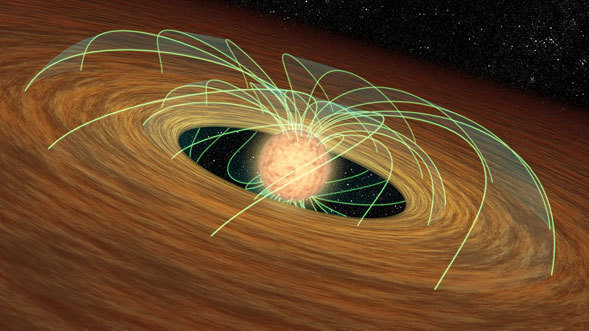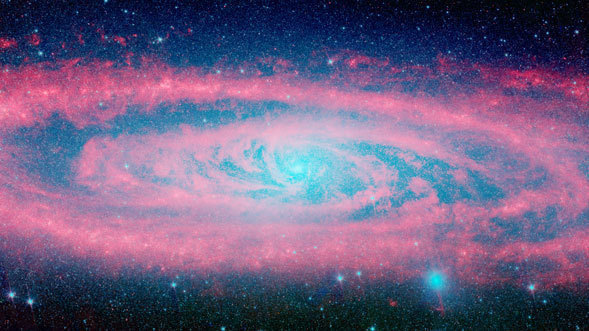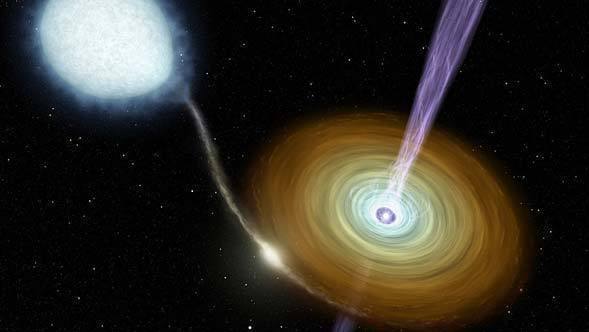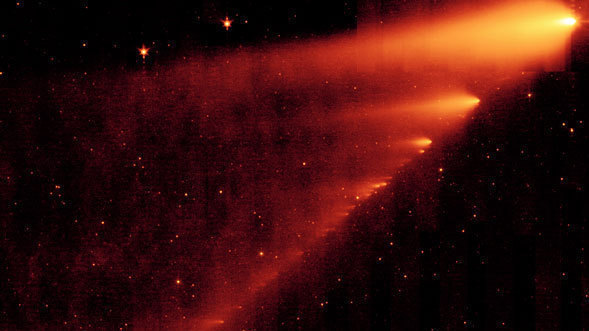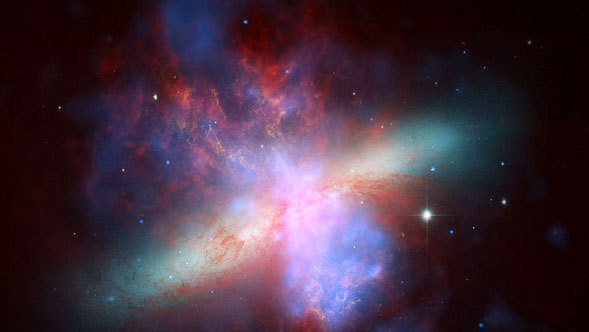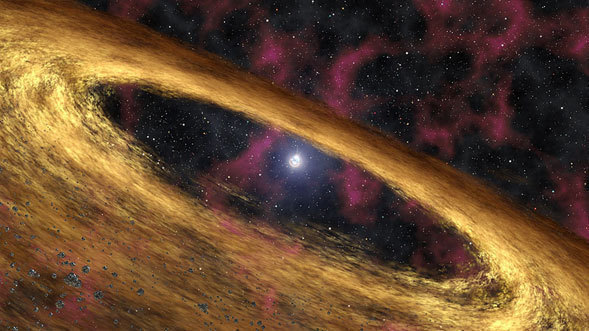Displaying news 451 - 480 of 587 in total
Engineers and scientists working on the recovery team brought NASA's Spitzer Space Telescope out of safe mode and restored it to normal mode late Tues., August 29. The observatory's three science instruments were successfully tested, clearing the way for science observations to resume today, Thurs., August 31. This means Spitzer is back on nominal operations.
A new image from NASA's Spitzer Space Telescope is helping astronomers understand how stardust is recycled in galaxies.
In three terrific years, NASA's Spitzer Space Telescope has peered into the heart of our Milky Way galaxy, detected partial ingredients for DNA in other solar systems, and uncovered evidence that planets might rise from a dead star's ashes.
Engineers are studying data returned by NASA's Spitzer Space Telescope, to determine what caused the observatory to enter safe mode on Friday, Aug. 18 at 2:52 p.m. Pacific time. After an unexpected reboot of Spitzer's main onboard computer, the spacecraft autonomously followed pre-programmed procedures, switched to the backup electronics system, and entered safe mode. The engineering and science teams have so far found no hardware or software problem to explain the unplanned reboot. In response to the safe mode entry, the Spitzer team has carefully maneuvered the spacecraft, which is in an Earth-trailing orbit around the sun, to point its high-gain antenna toward Earth. This change in attitude enables engineers to receive critical engineering data as quickly as possible. The project's engineers are carefully analyzing the data, trying to determine the next course of action to bring the spacecraft back to nominal operations.
Astronomers have long scrutinized the vast and layered clouds of the Orion nebula, an industrious star-making factory visible to the naked eye in the sword of the famous hunter constellation. Yet, Orion is still full of secrets.
Astronomers using NASA's Spitzer Space Telescope have found evidence that dusty disks of planet-forming material tug on and slow down the young, whirling stars they surround.
Shoes may not come in every color, but space objects do. All objects in space, everything from dust to distant galaxies, give off a rainbow of light -- including light our eyes can't see. That's where NASA's Great Observatories come in. Together, they help astronomers see all the shades of the cosmos.
Want to lift off into space, but don't have a rocket? Just stop by the Los Angeles County Arboretum & Botanic Garden on July 30, 2006, from 5 pm to 10 pm, and the Spitzer Science Center will bring the infrared universe to you!
In 1987 a massive star exploded in a neighboring galaxy, an event called a supernova. It was the closest supernova to Earth since the invention of the telescope centuries ago. Now, a team using the Spitzer Space Telescope and the 8-meter Gemini South infrared telescope in Chile have probed the supernova remnant and found the building blocks of rocky planets and all living creatures.
Adela Fedor has yet to receive a PhD, high school diploma, or even finish the eighth grade, but that did not stop her from using NASA's Spitzer Space Telescope to study a mysterious stellar species, called "iron stars."
Yale University
Start with lots and lots of dark matter, then stir in gas. Let the mixture sit for a while, and a galaxy should rise up out of the batter.
When the universe was only 700 million years old, some of its galaxies were already filled with lots of dust. But where did all of this dust come from? Astronomers using NASA's Spitzer Space Telescope think they may have found the source in type II supernovae, the violent explosions of the universe's most massive stars.
A long, slender stream of ancient stars has been discovered racing across the northern sky. The stream is about 30,000 light-years distant from Earth and is flowing high over the Milky Way Galaxy at some 230 kilometers per second, or more than half a million miles per hour.
University of California, Berkeley
A team of astronomers using NASA's Spitzer Space Telescope has discovered a grand total of nearly 300 clusters of galaxies. Almost 100 of these are as far as 8 to 10 billion light-years away, which means they date back to a time when our universe was less than one-third its present age.
The Andromeda galaxy, named for the mythological princess who almost fell prey to a sea monster, appears tranquil in a new image from NASA's Spitzer Space Telescope. The mesmerizing infrared mosaic shows red waves of dust over a blue sea of stars.
University of California, San Diego
One of the most mysterious aspects of black holes is their ability to shoot small, steady jets of matter into space near the speed of light. Until the sensitive infrared eyes of NASA's Spitzer Space Telescope recently spotted one of these jets around a nearby neutron star, or super-dense dead star, black holes were the only known objects in the universe with this "talent."
Eight hundred light-years away in the Orion constellation, a gigantic murky cloud called the "Witch Head Nebula" is teeming with dust-obscured newborn stars waiting to be uncovered.
NASA's Spitzer Space Telescope has snapped a picture of the bits and pieces making up Comet 73P/Schwassman-Wachmann 3, which is continuing to break apart on its periodic journey around the sun. The new infrared view shows several chunks of the comet riding along its own dusty trail of crumbs.
Big stars usually aren't shy about anything, not even death. At the end of their lives, they throw explosive tantrums, called supernovae, flinging abundant amounts of hot gas and radiation into space. Remnants of this cosmic fury can last for several thousand years and be easily detected by most telescopes used by professional astronomers.
Dr. Michael Werner, project scientist of NASA's Spitzer Space Telescope, has been selected to give the Royal Astronomical Society's distinguished 2006 George Darwin Lecture.
Comet 73P/Schwassman-Wachmann 3 cannot seem to hold itself together. During a visit to the inner solar system in 1995, the icy dirtball began to fall apart.
Self-help books and grade school teachers have been promoting this tip for decades: To keep success in sight, make a list of goals.
A pair of dancing galaxies appears dressed for a cosmic masquerade in a new image from NASA's Spitzer Space Telescope.
NASA's Spitzer, Hubble, and Chandra space observatories teamed up to create this multi-wavelength, false-colored view of the M82 galaxy. The lively portrait celebrates Hubble's "sweet sixteen" birthday.
It probably comes as no surprise that as powerful as our telescopes are, there are limits to what they can see. As we look farther out into the universe, objects appear smaller and dimmer to us, until at some point, we can't see them as discrete objects any more. But limits are always tantalizing. After all, the most distant objects in the universe are also the youngest (due to the finite speed of light), and therefore desperately interesting to astronomers. Of course, the more distant an object, the fainter it is likely to be. Will we ever be able to see things faint enough to find the very first starlight emitted by the first stars and galaxies? For the time being, we have no telescope with the resolving power and sensitivity to see galaxies that far away. But astronomers have never been good at leaving well enough alone and accepting limitations. Lately, a group of astronomers using the Spitzer Space Telescope have found a method of observing distant galaxies that are, in fact, too faint for Spitzer too see.
Old and new participants of the Spitzer Space Telescope Fellowship program will meet at the Spitzer Science Center on April 10 and 11, 2006, for a symposium that will address astronomical topics ranging from cosmic dust to a species of "failed stars," known as brown dwarfs.
NASA's Spitzer Space Telescope has uncovered new evidence that planets might rise up out of a dead star's ashes.
Displaying news 451 - 480 of 587 in total




